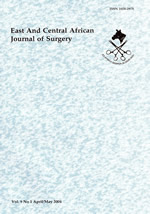
|
East and Central African Journal of Surgery
Association of Surgeons of East Africa and College of Surgeons of East Central and Southern Africa
ISSN: 1024-297X
EISSN: 1024-297X
Vol. 17, No. 1, 2012, pp. 112-120
|
 Bioline Code: js12020
Bioline Code: js12020
Full paper language: English
Document type: Research Article
Document available free of charge
|
|
|
East and Central African Journal of Surgery, Vol. 17, No. 1, 2012, pp. 112-120
| en |
Management of Posterior Urethral Valves at Kilimanjaro Christian Medical Centre: A 10 Years Experience.
Mteta, K.A.; Kaali, S.N.; Musau, P. & Mchembe, M.D.
Abstract
Background: Posterior urethral valve (PUV) disorder is an obstructive developmental anomaly in the urethra and genitourinary system of male newborns. A posterior urethral valve is an obstructing membrane in the posterior male urethra as a result of abnormal in utero development. This study was aimed at reviewing the management and outcome of treatment of PUV at KCMC among children presented for treatment during the period from January 1998 to December 2007.
Methods: This was retrospective hospital based review of 56 patients treated for posterior
urethral valves. The study was conducted in the Institute of Urology at Kilimanjaro Christian
Medical Center, which is a tertiary referral hospital located in northern part of Tanzania. The
study population was consisted of all children diagnosed to have posterior urethral valves in the
study period. All the children clinically suspected to have posterior urethra valves had the
diagnosis confirmed by micturating cystourethrogram and depending on their age, underwent
initial vesicostomy and finally posterior urethral valve fulguration as the definitive treatment.
Data regarding age at presentation, types of valves seen, clinical presentation, initial treatment
given, definitive treatment and complications of definitive treatment of PUV was extracted.
Information on outcome of definitive treatment of PUV was also extracted. The information was
transferred to a data sheet for analysis.
Results: At presentation 57.1% of patients were aged below two years while 16.1% were above
six years of age. Hydronephrosis occurred in 94.6% of patients. A dribbling urinary stream was found in 82.1% of patients. Urinary tract infection was also common, being present in 58.9% of patients. Fifty percent of patients presented with urine retention while vesicoureteral reflux was found in 23.2%. Of the valves seen 96.9% were type I. Initial treatment comprised of vesicostomy (42.9%), initial valve ablation (51.8%) and urethral catheterization 5.3%. Electrofulguration was the mainstay of definitive treatment of PUV and was instituted in all of the definitively treated patients. Urethral stricture as a complication was seen in 8.9% of the patients. Residual valves were seen in 20% of patients. A treatment success rate of 86.7% was observed. A mortality rate of 5.4% was found.
Conclusion:The clinical presentation of PUV and the age at presentation is similar to that seen in Europe and America. Type I valves form the majority of posterior urethral valves. Electrofulguration is the mainstay definitive treatment of PUV at KCMC. The success rate of treatment of PUV is good and compares with that seen in Europe and America.
|
| |
© Copyright 2012 - East and Central African Journal of Surgery
|
|
